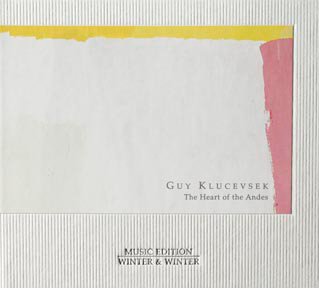|  THE HEART OF THE ANDES THE HEART OF THE ANDES
No wonder Guy Klucevsek has had such a long career as a composer and performer for the worlds of theatre and dance. His music just begs to have a screen or a stage as accompaniment! One can imagine the action when listening to the above pieces, and for anyone performing these pieces, that is exactly what they must have in abundance: a vivid imagination to interpret them in the outstanding manner that Klucevsek so successfully captures!
This is not the big, bombastic playing that some people favor, nor is it the barrage of terrifically fast fingers running races in both hands. But it is indeed beautifully performed with lovely phrasing, clean and clear technique, and wonderfully tasteful choices in registration and the sometimes too short snippets of melody, often too fleetingly developed, are interesting and worthy of attention. Klucevsek uses both stradella and free bass left hand to great advantage and, once again, proves the modern day accordionist must be proficient in both hands and with both left hand systems.
He uses a multitude of challenging rhythms at various times, infusing changing patterns of accents which, by the way, are not garishly over played. This is contemporary music but it is not the kind that people often say they do not like to hear; there is plenty of melodic interest happening. Oh, yes, there is indeed one use of the bellows shake, but it is so tastefully employed you will never know it until you realize you're hearing an accordion technique that enhances the performance of the music.
The sound of the accordion is hard to record; this is recorded exceptionally well. The instrument really sounds good! Perhaps we have better sound engineers than in the past. There are no forced or over-played reeds, whether with the deep growling lows of the bass (as in The Heart of the Andes, for example, or The Prelude #3) or with the piercing highs of the right hand heard beautifully and clearly over these lows. And the alternation of sounds between the hands (Three Chase Scenes, particularly) blend so well you will not distinguish between the two. You will find a musically well performed bellows vibrato in #21's Reprises.
The pieces are uniformly interesting. I am sure each of us will have our own particular favorites among them. Be sure to check out #5. The Air Apparent and #6. Old Miner's Refrain. In the latter you will believe you are at an old time hymn-fest for sure! I found #8. The Birds simply lovely with charming dynamic control with a left hand melody so pure and clear. Very stylish! And #18. The Gift…we are not given a clue about this gem, but I can well imagine it as a shy and unassuming Valentine's Day offering. I cannot forget mentioning #21. Mini Bar Talk, another very attractive and far too short jewel exhibiting the tiniest bit of a jazzy improvisational feel.
As you may assume from the above, I enjoyed this recording. I also admired the tasteful and somewhat restrained musicianship so thoroughly artistic and evident throughout.
Reviewed by Joan Cochran Sommers.
|

